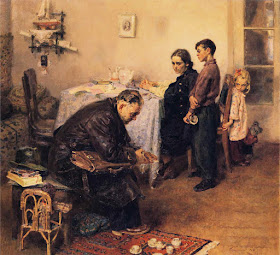Artists have compassionately portrayed the challenges that wives sometimes face when things go wrong for their husbands.
 |
| Sergei Grigorev - He's Come Back, 1954 |
In Sergei Grigorev's Soviet-era painting, the man of the house has returned home. He set his hat and a couple of gifts on his daughter's toy table, hardly noticing the little teacups at his feet. He slumps forward, looking inward, clutching a cigarette and cradling a leather satchel in his lap. There's a picture of the smiling young wife on the wall, but an empty space where her husband's picture had been.
Evidently he is educated and relatively prosperous, but perhaps he is in political trouble or he has just returned from the Stalin-era labor camps (Khrushchev had just come into power when this painting was finished). Far from being elated or surprised to see him, as in Repin's They Did Not Expect Him, each member of his family looks upset. The wife seems resigned, the son conflicted, and the daughter fearful.
 |
Vladimir Makovsky, At the Boulevard, 1887, Tretyakov Gallery
|
Makovsky portrays a young couple on a park bench, but it's not a holiday. It is bitter cold. The wife bundles her baby, and has a cloth-wrapped parcel on the bench beside her. She looks down in worry. Her husband plays his accordion, oblivious to her and their apparent homelessness.
 |
| The Mora Fair, 1892 - Anders Zorn, Swedish |
The plight of the wife in Zorn's painting is even worse, for her husband is passed out drunk after the fair. No one is stopping to help. She loyally holds his hat and waits for darkness to envelop them.
Each of these paintings speaks to the power of painting to tell gripping human stories on a par with the novelist's art. The difference is that in a novel there is an ending, but in a painting, the outcome will forever be unknown.
----
A good book for Russian realist painting from the late 19th century through the Soviet era is Socialist Realist Painting , published by the Yale University Press
, published by the Yale University Press
Each of these paintings speaks to the power of painting to tell gripping human stories on a par with the novelist's art. The difference is that in a novel there is an ending, but in a painting, the outcome will forever be unknown.
----
A good book for Russian realist painting from the late 19th century through the Soviet era is Socialist Realist Painting

This comment has been removed by the author.
ReplyDeletepoignant illustrations!
ReplyDeleteProof once more to me: There's hardly any difference between Illustration and fine art.
Thanks for sharing the analysis behind these paintings.
ReplyDeleteIt is very interesting to know so much emotions that can be conveyed by a painting
provided one takes note of every detail.
This comment has been removed by the author.
ReplyDeleteI love these images. They do a great job of storytelling and evoking emotion. They reminded me of an illustration by Saul Tepper that I use when I teach workshops on color. Titled "The Makeup Time", it is a piece depicting a young couple in moonlight, the man has his head down, while the girl has her back turned to him. Certainly some sort of argument or disagreement has occurred. I have two versions of this painting, one in it's original blue hued moonlight, and one in reds that I color balanced in Photoshop. When I show the two paintings, they have completely different moods. The first feels sad and somber, the second seems angry. In fact, most people don't notice the man's clenched fists until they see the red colored version.
ReplyDeleteYou can see the difference in color and emotion here at my blog. I would have posted them here, but didn't know how to do that.
https://vandervinnestudio.com/blog/126264/the-emotion-of-color
I've never interpreted Grigoryev's "He's Come Back" as any kind of political statement. It is easily readable as a man who had nearly left his family for another woman coming back in shame after it did not work out with her (or probably after he got in trouble for it - in the USSR an affair could ruin a party member's career).
ReplyDeleteWhile Eugene's interpretation, although very plausible, is not the only plausible one, I seriously doubt that [maybe] he has just returned from the Stalin-era labor camps could work. The leather portfolio and the presents are somehow incongruous...
ReplyDeleteThank you for highlighting and analyzing these paintings!
Great post! This really brings the works to life - better insight about the 'inner activity' in the scene. Thank you for bringing this to my attention.
ReplyDelete